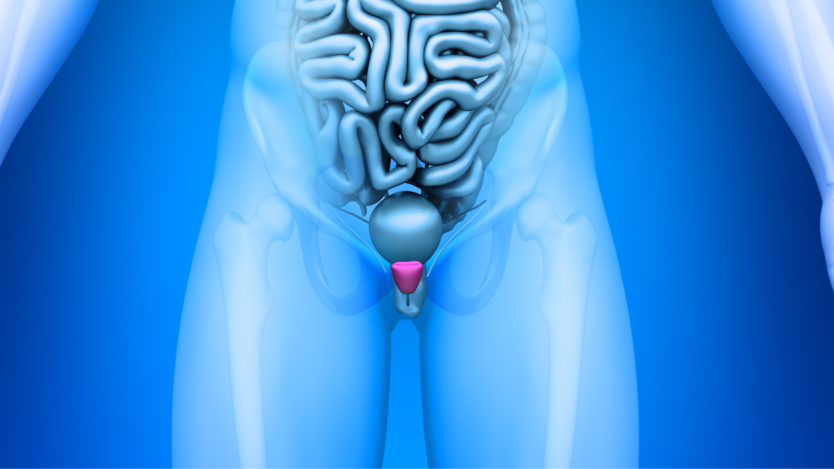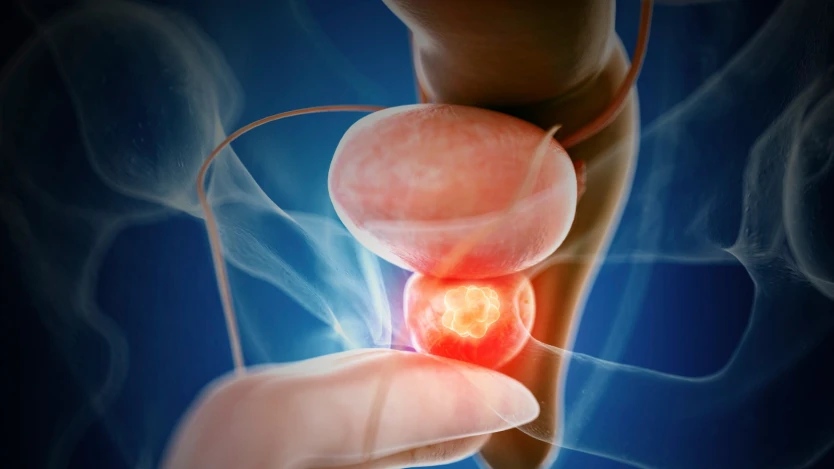BPH, causes, symptoms and treatments

- What is benign prostatic hyperplasia (BPH)?
- Causes of benign prostatic hyperplasia (BPH)
- Symptoms of an enlarged prostate (BPH)
- Diagnosis of benign prostatic hyperplasia
- Preventive and pharmacological treatment for BPH
- Prostate Surgery (Benign Prostatic Hyperplasia)
- Frequent Questions
- Benign prostatic hyperplasia involves an enlarged, non-cancerous prostate.
- Some of the symptoms associated with BPH are decreased voiding strength or discomfort when urinating, which usually worsen over time.
- If BPH does not respond to drug treatment, the specialist will recommend surgery as the only effective treatment for prostate reduction.
What is benign prostatic hyperplasia (BPH)?
Benign prostatic hyperplasia (BPH) is the non-cancerous enlargement of the prostate. The disease is related to ageing, as the likelihood of developing the disease increases as men get older.
Urinary problems caused by benign prostatic hyperplasia occur with ageing.
Although BPH is not a risk factor for the development of prostate cancer, it is important to detect enlargement early to prevent complications and improve quality of life.

Do you need prostate surgery?
Request a free and immediate appointment with our specialists in Urology
To diagnose the disease, the urologist will check the degree of prostatic hypertrophy by digital rectal examination. Thus, the severity will vary from grade 1, where the prostate can reach twice its size, to grade 4, where the limits of the disease cannot even be identified.

Almost all men over the age of 55 develop microscopic benign prostatic hyperplasia. However, in only 50% of cases will the hyperplasia be macroscopic, i.e. the prostate will be enlarged. And, of the latter, only 50% will have identifiable clinical problems.
Causes of benign prostatic hyperplasia (BPH)
Although the exact cause of benign prostatic hyperplasia is not known, there are several factors that may influence the growth of the prostate gland:
- Ageing
- Hormonal changes that occur with ageing
- Testosterone levels, which vary as a man ages.
- Family history
Ageing and male sex hormones are linked to the development of BPH.
On the other hand, one of the most frequently asked questions in medical consultations is about the risk of developing cancer as a result of BPH. The answer to this is NO. Having benign prostatic hyperplasia does not increase your chances of developing cancer.

Symptoms of an enlarged prostate (BPH)
The symptoms of BPH are related to problems with urination. They can be differentiated according to whether they are obstructive, preventing urine from flowing out of the bladder, or irritative, causing more annoying problems:
Obstruction of the prostate
- Intermittent urination: Difficulty in initiating urine discharge as well as intermittent urination.
- Reduced force and calibre of stream: Patient urinates much softer than normal.
- Incomplete emptying of the bladder. In these cases, the patient has the sensation that he or she has not managed to empty the bladder completely.
Irritation of the prostate
- Dysuria, painful urination. This may be due to an infection caused by urine retention in the bladder or the effort needed to urinate.
- Urgency of the bladder, i.e. the sensation of an urgent need to urinate.
- Increased frequency of urination, especially at night.

Do you need prostate surgery?
Request a free and immediate appointment with our specialists in Urology
The symptoms of this disease are very bothersome and get worse over time.
BPH is often associated with a marked reduction in quality of life.
In most cases, therefore, pharmacological treatment is necessary, and if this is not sufficient, surgical treatment is necessary to treat the enlarged prostate.

Benign prostatic hyperplasia is a growth that arises towards the nucleus of the prostate, thus compressing the urethra and obstructing the passage of urine. It is therefore important to note the diseases that produce symptoms similar to those of an enlarged prostate:
- Infected urinary tract
- Prostatitis (inflamed prostate)
- Constriction of the urethra
- Scars arising from previous surgeries
- Stones in the kidneys and bladder
- Condition of the nerves that control the bladder
- Prostate or bladder cancer
Diagnosis of benign prostatic hyperplasia
To make a correct diagnosis, the specialist will perform a series of diagnostic tests:
- A physical examination of the kidneys, bladder, testicles and, above all, the prostate. A digital rectal examination allows the doctor to assess the size, shape and consistency of the prostate and to detect any hard nodules suggestive of cancer.
- A urinalysis helps the specialist to know if there is any type of urine infection.
- An ultrasound is used to measure the amount of urine accumulated in the bladder.
- A cystoscopy, in which a light tube is inserted through the penis into the bladder.

Do you need prostate surgery?
Request a free and immediate appointment with our specialists in Urology
Basic prostate screening should include a blood test, determining PSA, a prostate-specific antigen. PSA is a protein produced by prostate cells and is also an indicator of prostate disease.
PSA is elevated in benign prostatic hyperplasia, prostatitis and prostate cancer. However, this does not mean that having a PSA at a certain value implies cancer. PSA rises with an enlarged prostate, which may be benign or due to infection (prostatitis).
Preventive and pharmacological treatment for BPH

For benign prostatic hyperplasia there is a wide range of treatments that will vary depending on the tolerability of the symptoms. Thus, if symptoms are mild to moderate, the specialist will recommend surveillance and drug treatment:
- Alpha-blockers: help relax the muscles at the base of the bladder and increase a man's ability to urinate.
- Inhibitors: prevent the hormonal changes that cause prostate enlargement.
- Combination of drugs: alpha blockers and inhibitors work best when taken together. Therefore, the specialist will recommend combining them if they do not work separately.
- Tadalafil: although initially indicated to treat erectile dysfunction, it is also used to treat prostate enlargement.
In addition, certain guidelines may be recommended to alleviate the most bothersome symptoms:
- Avoid a sedentary lifestyle, foods high in saturated fats and alcoholic drinks.
- Drink plenty of water
- Do not hold back the urge to urinate unnecessarily.
- Do not exert sudden pressure on the abdominal muscles.
If the symptoms not only do not subside with pharmacological treatment, but continue to worsen and become more noticeable, the specialist will recommend surgery.
Prostate Surgery (Benign Prostatic Hyperplasia)
Prostate surgery is performed to relieve the obstruction caused by benign prostatic hyperplasia (BPH), i.e. the excessive growth of the prostate. This relieves the pain that the enlarged prostate causes in the urethra, as well as the associated unpleasant symptoms.

Laser treatment for prostate enlargement
Laser prostate surgery is an operation performed to treat benign prostatic hyperplasia with a minimally invasive manoeuvre. Thus, laser surgery is performed as follows:
- First, the specialist will administer a general anaesthetic so that you do not feel any discomfort during the procedure.
- Once it has taken effect, the cystoscope and the laser fibre are inserted through the urethra, which has previously been dilated.
- Depending on the laser chosen, the technique may involve vaporisation, enucleation or vapour-resection, among others.
- Once all the prostate tissue has been removed, all the instruments are removed and a probe is left in place to eliminate any remains that may have been left inside.
We therefore differentiate between different laser techniques for prostate surgery:
- Holmium Laser makes it possible to operate on any size of prostate and has the advantage of reducing post-operative complications to a minimum.
Depending on the characteristics you present, the Holmium operation will be performed by prostatic enucleation or vaporisation.
In the Holmium Laser Enucleation (HoLEP) operation, the prostate adenoma is separated from the prostate capsule and the bleeding areas are cauterised.
During the Holmium Laser Vaporisation (HoLAP) surgery, the cuts made to remove the tissue are very precise, allowing for a reduction in intraoperative bleeding. However, this technique is only indicated for prostates weighing no more than 50 grams.
- Thulium Laser can also be used to operate on prostates of all sizes. However, it will be the specialist who will indicate the suitability of the laser, as in cases of excessively large prostates, it may be advisable to use the Holmium Laser.
As with Holmium, Thulium surgery (ThuLEP) can be performed using two techniques: vaporisation and vapour-resection.
In Thulium Laser prostate surgery, vaporisation is performed by evaporating the prostate tissue by heating it. The intracellular water reaches up to 100 degrees, thus minimising common bleeding and creating a haemostatic effect.
In the case of the operation with Thulium by vapour-resection, the same steps are followed as in the previous technique, but combined with the resection of the tissue by means of a laser beam.
- GreenLight Laser technique is indicated for prostates of 50 cc and, in any case, admission will not last more than 2 days, as in the case of the two lasers mentioned above.
This surgery is performed by vaporising the tissue and cauterising the surrounding tissues.
This not only minimises bleeding, but also reduces recovery time compared to conservative methods. In addition, the Green laser reduces postoperative complications to 0.1%.
Other surgical techniques for the treatment of BPH
In addition to laser surgery, there are several other surgical treatments that can be used to solve the problems of Benign Prostatic Hyperplasia. However, the use of each will depend on the size of the prostate, the health of the patient and the opinion of the surgeon.
Transurethral resection of the prostate
TURP (Transurethral Resection of the Prostate) is recommended and indicated for patients with prostates smaller than 60 cc.
It is the perfect option for men with moderate to severe urinary problems, who have undergone drug treatment but symptoms have not subsided.
Urethral release with the Urolift System
Urolift System is a minimally invasive technique, so hospitalisation is not necessary.
With this technique, the symptoms of Benign Prostatic Hyperplasia (BPH) are relieved without affecting sexual function.
It is indicated for men with prostates smaller than 60 cc, being more effective in sizes smaller than 50 cc.
Water Vapour Prostate Surgery
The main advantage of the Water Vapour Technique for BPH is its minimally invasive technique, which is suitable for men who do not want to compromise their sexual activity.
Although there is no specific age to be able to undergo surgery with this technique, it is suitable for patients who are at risk for more invasive surgical options. However, it is only feasible with small to medium-sized prostates (weighing between 30 - 80 grams).
If you have a clear diagnosis of BPH and you are thinking of treating your prostate problems with surgery, we remind you that you can request a free surgical assessment appointment with a Urology specialist by clicking below:

Do you need prostate surgery?
Request a free and immediate appointment with our specialists in Urology
Medical disclaimer: All the published content in Operarme is intended to disseminate reliable medical information to the general public, and is reviewed by healthcare professionals. In any case should this information be used to perform a diagnosis, indicate a treatment, or replace the medical assessment of a professional in a face to face consultation. Find more information in the links below:
Frequent Questions
-
What happens if I have an enlarged prostate?
Progressive prostate growth is quite common and normal in men from the age of 45 onwards. Over the years, the prostate may increase in volume and can eventually double or even triple its normal size.
This enlargement of the prostate is known as Benign Prostatic Hyperplasia (BPH)—a medical condition that causes obstruction in the urinary tract, leading to urinary incontinence in the patient.
Over time, if left untreated, BPH can result in more serious symptoms such as urinary tract infections, kidney pain, bladder stones, or the presence of blood in the urine.
